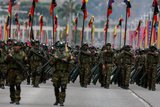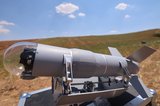Northrop Grumman, US Navy complete new flights of X-47B UCAS
Less than a month after completing the first flight of the US Navy's X-47B UCAS-Demonstration aircraft, flight test engineers from Northrop Grumman Corporation and the Navy have successfully completed the aircraft's second and third flights.
The flights, both conducted at Edwards Air Force Base, mark the beginning of a process called envelope expansion during which the test team will begin proving that the tailless aircraft can perform safely over a broad range of altitudes, air speeds and operating weights.
During the X-47B's 39-minute second flight on March 1, the aircraft flew to an altitude of 7,500 feet at speeds up to 200 knots. During its 41-minute third flight on March 4, the aircraft reached an altitude of 7,500 feet and a top speed of 180 knots. By comparison, the X-47B flew only to 5,000 feet at a top speed of 180 knots during its first flight Feb 4.
"Conducting two flights of a brand new type of aircraft within one week, and both within a month of first flight speaks not only to the robust design of the X-47B aircraft, but also to the dedication and engineering skills of the joint UCAS-D flight test team," said Janis Pamiljans, vice president for the Navy UCAS program for Northrop Grumman's Aerospace Systems sector. "These flights continue to add momentum to the team's march toward demonstrating in 2013 that we can safely operate this tailless, low-observable-relevant air system on a Navy aircraft carrier."
According to Phil Saunders, chief engineer for Northrop Grumman's Navy UCAS program, envelope expansion is designed to fully characterize the aircraft's flying qualities and prove that they match the system's performance requirements and the test team's predictions.
"Over the next few flights, we'll continue to expand the envelope in terms of air speed, altitude and operating weight range," he said. "By gradually ramping up the complexity of requirements, we will systematically prove that this air system can safely take off, fly and land in all anticipated flight environments."
Northrop Grumman and the Navy expect to complete the planned 49-flight envelope expansion program at Edwards Air Force Base before moving the first X-47B to Naval Air Station Patuxent River, Md., later this year, he added.
One of the most important measures of performance, Saunders explains, is aircraft stability. The X-47B, which relies on high-speed computers to manage its flight control surfaces, must be able to adjust quickly and automatically to unpredictable environmental conditions such as air turbulence or cross winds. The recent test flights included a series of maneuvers designed to measure the aircraft's ability to maintain a smooth, level flying state in the presence of such conditions.
The flight tests also confirmed that the X-47B's flush mounted air data system - a nod to its low-observable-relevant design - is accurately sensing and communicating the aircraft's air speed, a critical factor in takeoff and landing.
In addition, the flight tests gave the team the opportunity to validate the aircraft's engine performance; its command and control system, and its ability to fly at a constant angle of attack and a constant rate of descent while on final approach to landing, simulating what it will have to do to make successful landing on an aircraft carrier.
The Navy awarded the UCAS-D prime contract to Northrop Grumman in August 2007. The six-year contract calls for the development of two X-47B fighter-sized aircraft. The program will demonstrate the first-ever carrier launches and recoveries by a tailless, unmanned aircraft. Autonomous aerial refueling will also be performed after carrier integration and at-sea trials.
Northrop Grumman's UCAS-D industry team includes GKN Aerospace, Lockheed Martin, Pratt & Whitney, Eaton, GE, Hamilton Sundstrand, Dell, Honeywell, Goodrich, Moog, Wind River, Parker Aerospace and Rockwell Collins.
Source: Northrop Grumman
More from Uncrewed Vehicles
-
![What's next for the Pentagon after the Replicator programme?]()
What's next for the Pentagon after the Replicator programme?
Although the Replicator initiative has made several accomplishments, there are still multiple gaps to plug across the US Department of Defense (DoD) and its services.
-
![Cummings Aerospace showcases Hellhound loitering munition designed for US Army’s LASSO programme (video)]()
Cummings Aerospace showcases Hellhound loitering munition designed for US Army’s LASSO programme (video)
Cummings Aerospace presented its turbojet-powered Hellhound loitering munition at SOF Week 2025, offering a man-portable solution aligned with the US Army’s LASSO requirements.
-
![SOF Week 2025: PDW unveils attritable FPV drone for SOF operations at scale]()
SOF Week 2025: PDW unveils attritable FPV drone for SOF operations at scale
PDW has revealed its Attritable Multirotor First Person View drone at SOF Week 2025, offering special operations forces a low-cost, rapidly deployable platform for strike and ISR missions, inspired by battlefield lessons from Ukraine.
-
![SOF Week 2025: Teledyne FLIR white paper provides guidance on reusable loitering munitions]()
SOF Week 2025: Teledyne FLIR white paper provides guidance on reusable loitering munitions
Teledyne FLIR is highlighting the emerging requirements for 'recoverable and re-usable' loitering munitions across the contemporary operating environment during this week’s SOF Week conference in Tampa, Florida.
-
![SOF Week 2025: Kraken Technology group debuts K3 Scout USV in North America]()
SOF Week 2025: Kraken Technology group debuts K3 Scout USV in North America
High-performance maritime industry player Kraken Technology Group, based in the UK, has used the SOF Week conference in Tampa, Florida this week to debut its K3 Scout uncrewed surface vessel (USV) to the North American market.
-
![Palladyne AI and Red Cat to demonstrate capabilities for autonomous drone swarms to the US military]()
Palladyne AI and Red Cat to demonstrate capabilities for autonomous drone swarms to the US military
Red Cat and Palladyne AI recently conducted a cross-platform collaborative flight involving three diverse heterogeneous drones.

























